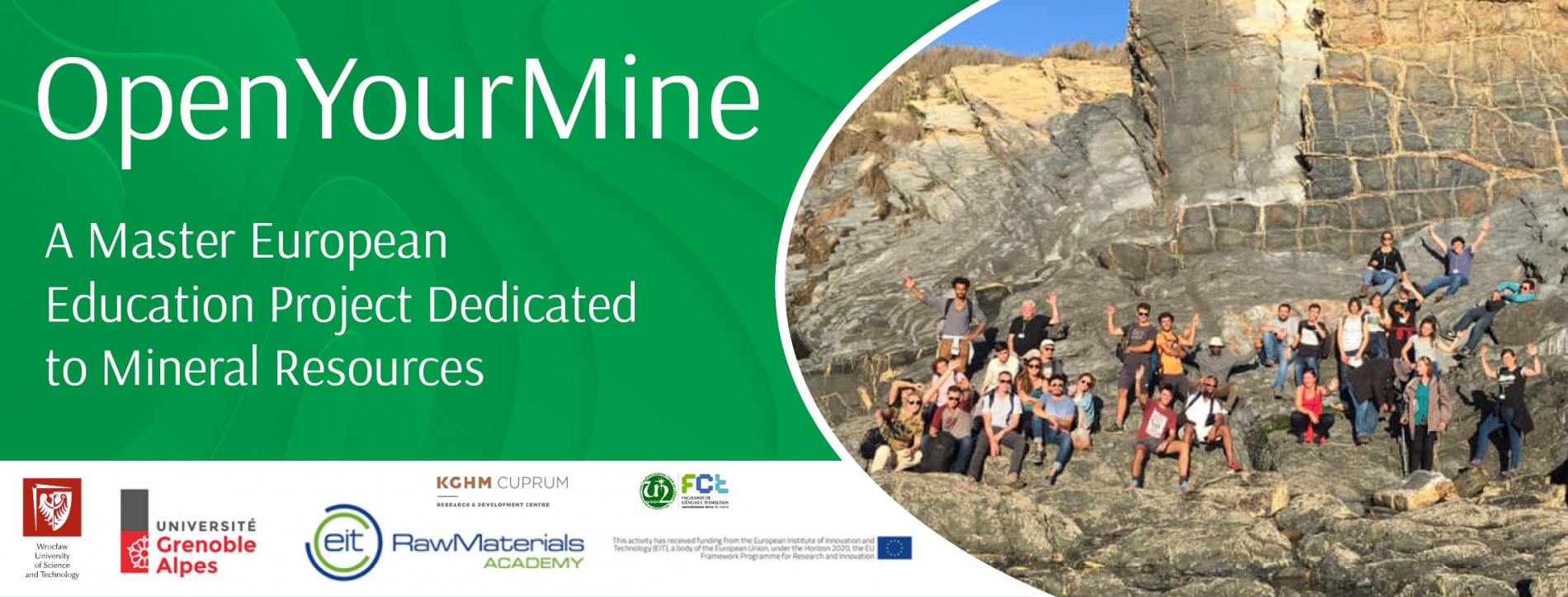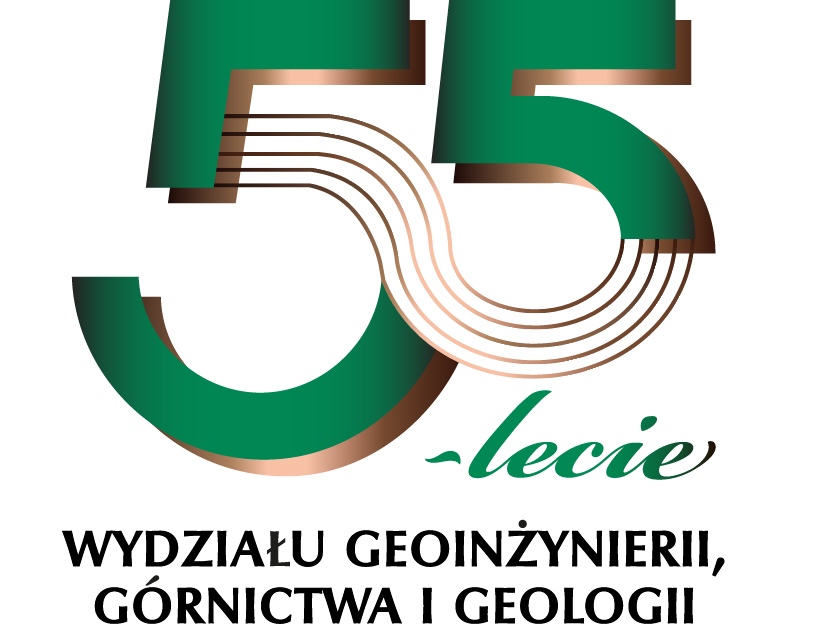OpenYourMine
A Master European Education Project Dedicated to Mineral Resources
OpenYourMine project is financially supported by European Institute of Innovation and Technology EIT/EIT RawMaterials
The OpenYourMine project lasts 3 years from 2019 to 2021

W dniach od 21 października do 1 listopada grupa Studentów Wydziału Geoinżynierii, Górnictwa i Geologii PWr pod opieką dr inż. Anny Gogolewskiej (polskiego opiekuna projektu) oraz dr inż. Moniki Derkowskiej uczestniczyła w wizycie studyjnej w ramach Europejskiego Programu Edukacyjnego dla Studentów Studiów Magisterskich Poświęconego Surowcom Mineralnym "Open Your Mine” w Portugalii.
Nasi Studenci przez dwa tygodnie, wraz ze studentami z francuskiej uczelni Université Grenoble Alpes oraz portugalskiej Universidade NOVA de Lisboa poszerzali swoją wiedzę z dziedzin takich jak zasoby i surowce mineralne, zrównoważony rozwój w górnictwie czy surowce energetyczne.
Lead Partner: University Grenoble Alpes (UGA)
Project Coordinator: Laurent Truche (PR UGA IsTerre) laurent.truche@univ-grenoble-alpes.fr
Partners Two Universities
Wroclaw University of Science and Technology, Faculty of Geoengineering, Mining and Geology, (WUST)
Local Coordinator: Anna B. Gogolewska, anna.gogolewska@pwr.edu.pl
NOVA University of Lisbon, Faculty of Science and Technology (FCT-Nova)
Local Coordinator: José Almeida, ja@fct.unl.pt
One industrial Partner with an R&D Center
KGHM CUPRUM Ltd. Research and Development Center
Local coordinator: Malwina Kobylańska, mkobylanska@cuprum.wroc.pl
Creation of four Master level teaching units
WP2: Mineral resources and sustainable development – 3 ECST teaching units (for mining specialists)
Covered subjects that concern students specializing in mining: stratified copper deposits; introduction to GS special analysis; application of GIS special analysis in mining; practical lab activities; LIBS and XRF measurements; acid mine drainage and contaminants; mines’ contamination and remediation; bioleaching; rock mechanics lab; separation of ores; use of mining residuals for construction materials; hazards in mines; geostatistics for resource evaluation and Leapfrog software; microscopy techniques in copper ore studies; geological stereo microscope view of sands and minerals.
WP3: Raw material energy nexus – 3 ECTS teaching units (for all students)
Six lecture hours on site followed by learning by doing activities. Interaction between mineral resources, energy and economy. Mineral resources-energy nexus in connection with the transition towards a low-carbon society. Dynamic modelling of reserve-production-recycling-demand-cost-price at the global scale on the long term.
WP4: New communication strategies for mining business – 3 ECTS teaching units (for all students)
Six lecture hours on site followed by an online seminar moderated by the teaching staff. Additional lectures focusing on European- mainly Spanish- examples of the use of mining related objects for teaching or tourism, on bioleaching and on hazards in mines.
In the on-line seminar students work in international and transdisciplinary groups of approximately four students and each group submits a case study on a mine or mining area. Work-in-progress is checked regularly. A final paper of approximately 10 pages in the form of publishable article is handed in by each group. The best papers will be published in an online forum moderated by teaching staff.
WP5: Field trip-The Iberian Pyrite Belt and its mining history– 3 ECTS teaching units (for all students)
The 2019 field trip took place in the Iberian Pyrite Belt with classes at the FCT NOVA University in Lisbon. The field trip with classes took place from 21st of October to 26th of October; the classes at University were from 28th of October to 1st of November. During the field trip students learnt about the complex mining history and economy of Iberian Pyrite Belt, about ore prospecting in the field and about the specifics of sand mine exploitation.
The OpenYourMine project lasts 3 years from 2019 to 2021.
In 2019 the end of online seminars, consultation and group and the submission deadline of individual works is in the end in December 2019. The evaluation by teachers’ staff is in the first week of January 2020.
Ten students and two teachers from Wroclaw University of Science and Technology, Faculty of Geoengineering, Mining and Geology, (WUST) took part in 2019 edition of the OpenYourMine project.
Teachers Anna B. Gogolewska and Monika Derkowska-Sitarz
Students
Nikolas Barwicki
Błażej Doroszuk
Mariusz Giża
Daria Golba
Katarzyna Kowalczewska
Dominika Olchówka
Aleksandra Otto
Wiktoria Sierszeń
Aleksandra Skorupa
Adam Wróblewski
8 students from University Grenoble Alpes (UGA) and 9 students from NOVA University of Lisbon, Faculty of Science and Technology (FCT-Nova) took part in project with students from WUST.
FIELD TRIP 2019
22nd of October 2019
Iberian Pyrite Belt (IPB) and Sao Domingos mine
Iberian Pyrite Belt (IPB), located in the southwest part of the Iberian Peninsula, is one of the largest metallogenetic provinces of massive sulphide deposits in the world with original reserves over 1,700 Mt. The mining and metallurgical activity were the economic support in the region of numerous civilizations seated since the pre-Roman periods.
 Iberian Pyrite Belt (IPB) and Sao Domingos mine and old processing plant (22nd of October 2019)
Iberian Pyrite Belt (IPB) and Sao Domingos mine and old processing plant (22nd of October 2019)
 Iberian Pyrite Belt (IPB) and Sao Domingos mine (22nd of October 2019)
Iberian Pyrite Belt (IPB) and Sao Domingos mine (22nd of October 2019)
23rd of October 2019
Trip to Aljustrel to Almina mine and processing plant (deposit of sulphide complex ore)
 Prospecting logging in Aljustrel, Almina mine (23rd of October 2019)
Prospecting logging in Aljustrel, Almina mine (23rd of October 2019)
 Geology department in Aljustrel, Almina mine: drilled cores of sulphide complex ore (23rd of October 2019)
Geology department in Aljustrel, Almina mine: drilled cores of sulphide complex ore (23rd of October 2019)
 23rd of October 2019, froth flotation of Aljustrel sulphide complex ore (23rd of October 2019)
23rd of October 2019, froth flotation of Aljustrel sulphide complex ore (23rd of October 2019)
 Students at Almina processing plant, froth flotation of Aljustrel sulphide complex ore (23rd of October 2019)
Students at Almina processing plant, froth flotation of Aljustrel sulphide complex ore (23rd of October 2019)
 Old mining working renovated for education and tourism purposes in Ajlustrel old and ancient mine (23rd of October 2019)
Old mining working renovated for education and tourism purposes in Ajlustrel old and ancient mine (23rd of October 2019)
24th of October 2019
Trip to Costa Alentejana at the Altlatic Ocean
 Costa Alentejana, geology of the Iberian Pyrite Belt at the Atlantic Ocean (24th of October 2019)
Costa Alentejana, geology of the Iberian Pyrite Belt at the Atlantic Ocean (24th of October 2019)
25th of October 2019
Trip to Montemor-o-Novo mineralisations, the main characteristics of Gold mineralizations in SW Iberia
(topic: ore prospecting and field work)
 Montemor-o-Novo (25th of October 2019)
Montemor-o-Novo (25th of October 2019)
26th of October 2019
Trip to Sifucel sand mine (exploitation from under water table) and processing plant
The mine produces kaolin, special siliceous sand, silica flour and washed pebble. it is situated in the Rio Maior industrial area, with an approximate area of 80 ha. Using the most modern methods (remote mining and processing controlling), it extracts a large share of productive sands, processing them in closed-circuit, with high technology equipment.

Sifucel sand mine, exploitation from under water table (26th of October 2019)
